-"A broadening of focus onto the international character of contemporary modernity...visions of the non-western world..." Contemporary art becomes a vehicle for bringing concerns into view, to the forefront.
-Representation of nearness of world peoples and cultures. From de-colonization to independence to modernization to globalization: overcoming role of the 'other.'
-Migration of artists from oppressed cultures into economic systems of the West, and the integration of many developing countires in to the global system of production and communication, removes the western-centric perspective and thus introduces art centers beyond Europe and the US. Which also leads to critiques of capitalism and "world economies."
--Technology and the impact of Global expansion in the electronic realm, furthers the blurring lines between high art and popular culture and creates a network of communiation that knows no geographical borders.
--An inquiry into national identities in the wake of the dismantling of political systems: Soviet Union, Eastern Europe, South Africa reveals new voices, renewed identities. "From unfreedom to freedom."
--Internationalization of the art world, through international network of art professionals and art exhibitions/fairs. Economy and culture are inextricably linked.
The example of Documenta 11, 2002 (Documenta always held in Assel, Germany).
Documenta 11 was specifically to show effect of globalization, and to show multi-disciplinary approach to visual arts.
Yinka Shoonibare, Glalantry and Criminal Conversation 2002
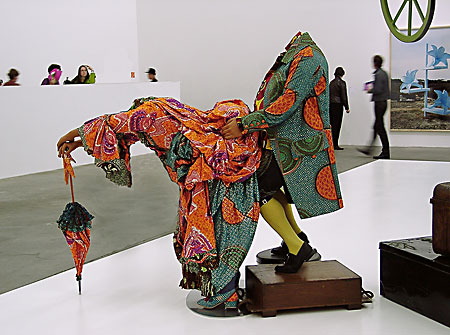
Reference to a "Grand tour," a country outing of noblemen in the 18th century. The costumes are tailored from printed African cloth.
Yinka Shonibare is someone born in England but born to Nigerian parents. Eventually moves back to Nigeria, but was also educated in England; so is truly bi-cultural, and uses this experience to confront what it's like to grow up in with Nigerian traditions but to be educated in Western culture.
-Most of Yinka's figures in his art are headless, which gives a type of anonymity.
The Swing (reproduction of Fragonard's 'the swing'), 2001

Maxa (detail) 2003 -- direct use of African fabrics. This work can be seen as a challenge to high or fine art as it enters this idea of craft (as opposed to doing a painting, etc).

Mona Hatoum, Homebound, 2000.
Installation


The installation entitled Homebound - furniture and household items united in an electrical circuit and fenced in by metal cables as a security zone - tells a story about the home and family as an unstable, exposed and dangerous zone.
"According to the prize committee, Mona Hatoum's contribution to the European visual arts tradition makes her an obvious recipient of the Sonning Prize. She has developed an aesthetically distinct, political language to express the experiences of refugees and immigrants and their need to balance identity somewhere between modern Europe and their non-European native countries.
As the nominating committee put it:
"In the world of culture, more specifically the world of visual arts, the British-Palestinian artist Mona Hatoum is someone who has found the most significant visual expression for the experience of 'New Europeans' as living on that unstable ground between two cultures, where you do not feel at home in either - not the one you left or fled from nor the one you have voluntarily or involuntarily become a part of."
The Committee's selection for the Sonning Prize winner is applauded by Oystein Hjort, professor in art history at the University of Copenhagen. "Mona Hatoum's works are both distinctive and visually astonishing," says Professor Hjort. "Her works reveal the individual, exposed and vulnerable, and she reflects disease, suffering and death, oppression, even torture in many of her pieces. The body is an important part of her working process, where taboos are challenged and dismantled in a continuous attempt to redefine the place of humanity in a politically infected world."
Mona Hatoum's relationship with the unsettled, fragmented and vulnerable identity felt by many "New Europeans" is nourished by personal experience with migration and exile - without this making her art a private affair. She was born in Beirut in 1952 to Palestinian parents who had been forced into exile, where she grew up with an ambivalent, unsettled sense of being both at home and homeless.
While on a visit to England at the age of 23, civil war erupted in Lebanon and she was prevented from returning home to her family. Instead, she applied to a school of art in London, where she has lived and work ever since. " -- exflux.com
On Kawara, One Million Years (Past and Future), since 1970. Machine-written directory, two sets of leatherbound books, each in a black box.
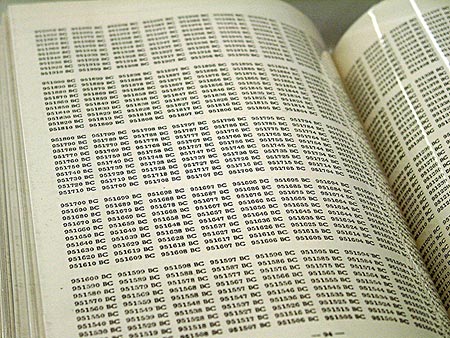
this book just lists the years since one million years ago.
PAST: all years from 998.031 BC until 1969.
FUTURE: all years from 1969 until 1.001.995 AD.
In the actual installation of this art, people in a glass cubicle are reading the years outloud.
DORIS SALCEDO - "6 November 1985" - installation done in 2001. Stainless steel, lead, wood, resin, and steel.
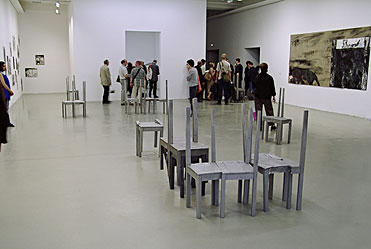
"On 6 November 1985, a commando of the guerrilla movement M-19 raided the Supreme Court in Bogotá and took everyone inside hostage. Without negotiating, the army and police force attacked the building with tanks and helicopters, etc., and set it on fire. Altogether, 53 Justice Department employees and visitors died, including 11 Supreme Court judges, as did all 35 guerrillas.
In No 45 of his Columna de Arena, José Roca wrote about the two installations:
The first is a series of chairs made of steel, wood, resin and lead, which are scattered in a large room as the remnants of a tragedy, melted together at the armrests, the seats or the legs. The other installation is a room crossed diagonally by the elongated lead chair legs, so that a space is created which relates to the tragedy (charred pieces of furniture, piled on top of each other). At the same time, their presence prevents access to the room, putting the viewer in the position of a powerless witness, or in the situation of "a glimpse that comes too late" - as Alfredo Jaar said in relation to photography of violence.
Pieces of furniture are elements which are in daily contact with the body. Their form and dimensions are like a continuation of it, which allows for a metonymical substitution of the furniture (in this case of the chairs) through the absent body." (source: http://www.universes-in-universe.de/car/documenta/11/frid/e-salcedo-2.htm)
TENEBRAE Noviembre 7, 1985, Installation.
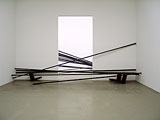
Poetic Justice 2003 Istanbul Biennial

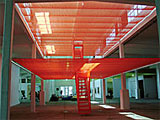
Emily Jacir, Where we come from, 2002-2003

Emily thought about the question, "If I could do anything for anyone living in exile, what could I do?" ..She explores the physical liberty of movement. How free ARE we to move about, in this global world, where boundaries SEEM to be eradicated and we SEEM to much more freedom...how free are we really to move around?
-Therefore, her project was the result of this question that she asked. She took a photo of the actual action of the enocunter of that wish (to do something for those living in exile). In both english and arabic (on the left in the photo) she has put their wish in writing.
-her work is based on documentation; her interpretation of their wish. One of her requests was, "go to hatha and play soccer with the first Palestinian boy you see on the street." She ends up playing soccer with a boy named Kamel (sp?).


No comments:
Post a Comment